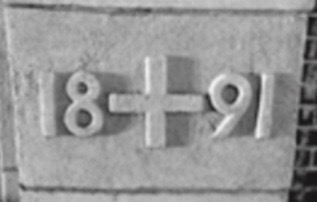
The Franciscan Friars arrived in Boston in 1873, and immediately were welcomed by the city’s growing Italian population, many of which viewed the order as patriarchal.
The Franciscans main objective was to service the needs of their parishioners, building churches, schools, and orphanages all for the use of the immigrant population, particularly in Italian communities. This is not to say that the Friars did not welcome all nationalities into their institutions, simply that the relationship between the Franciscans and Italian immigrants was always held in special regard. The number of Italians in Boston was still developing, numbering only in the hundreds, when the population petitioned Archbishop Joseph Williams to organize a parish.
In February of 1874, the Franciscans sent Father Joachim Guerrini, who began to service the Italian population at a nearby Portuguese Church located on North Bennet Street. After two years, he built a modest structure on Prince Street. It was dedicated on February 23, 1876, and named in honor of Saint Leonard of Port Maurice, a Franciscan credited with promoting the tradition of the Stations of the Cross, erecting them in Churches throughout Italy and in the famous Coliseum in Rome.

Some critics of the Franciscans who sought to construct a grander structure elsewhere within Boston’s Italian community began to demand restrictions on Saint Leonard’s and its parishioners. However, the Archdiocese intervened stating that such a situation was against Diocesan Statutes. From this failed protest, other Italian parishes were formed.
As the number of Italians continued to grow larger, in 1888, the Scalabrinian Missionaries arrived and established the Church of the Sacred Heart. The two parishes began to emulate each other, and through this both were successful in reaching the faithful. At the time, it was said that the Italians in Boston were perhaps the most practicing in the country. The fact that the two churches were geographically close, and that both were equally prosperous, clearly supports this theory.
The ongoing immigration created a need for the Franciscans to construct a larger Church. Upon completion of the lower level in 1891, dedicated in November of that year, work began on the upper level. The result was an artistic monument. Built in the Roman style, the structure contains three large naves, a majestic cupola and a grand sanctuary. It was officially dedicated in 1899, at a final cost of $160 thousand, today’s equivalent of $4.5 million. The Italian community finally had its crowning achievement. The structure may not have been achieved if not for Father Ubaldus Pandolfi, a man who was regarded as knowing no obstacles.
Between 1891 and 1904, Saint Leonard’s experienced its most glorious period under the guardianship of Father Pandolfi, who is revered as the Father of the Italian colony of Boston. During his tenure, the congregation of the parish grew to over 20 thousand.
Coming in Part III: A neighborhood church with a global impact
[hr]
Donations toward the restoration of St. Leonard Church can be made online here or by sending checks to St. Leonard’s Restoration Fund, 320 Hanover St., Boston MA 02113. All donations are tax deductible and you will receive a receipt within 2 weeks of your donation. For gifts from donor-advised charitable accounts use “St. Leonard of Port Maurice” Tax ID 04-2108397 and designate Church Restoration Fund.
Please join the Franciscan Friars and parishioners on Sunday, December 17 at the 12 noon Mass when Cardinal Sean O’Malley will be present for the Blessing of the church and the consecration of the altar officially reopening Saint Leonard Church. Light refreshments will be served following the Mass and ceremony.



